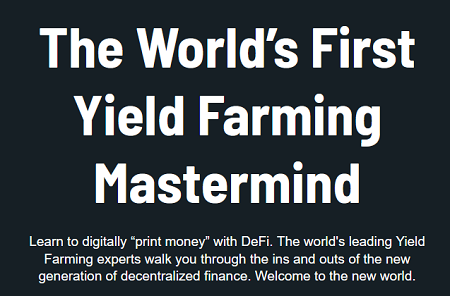Download Files Size:
10.1 GB
Value:
$997
What is Yield Farming?
People are betting big on crypto. And they’re not just using their own money, they’re borrowing thousands, even millions of dollars, to do it. But there aren’t any mainstream banks lending in crypto. So who’s doing the lending?
Individuals like you.
For the first time in history, anyone can be the bank and “farm the yield” that comes from it (ie. print massive amounts of digital dollars).

“ One of the hottest trends in cryptocurrencies…“yield farming” can earn double-digit interest rates, far higher than the rates one can

“ Yield farming is a cryptocurrency investment strategy that holds out the hope of bigger returns than most conventional investments … It could be a chance for the

“ …the liquidity providers, known in the DeFi space as “yield farmers,” can earn big profits fast to compensate for
Yield farming is a way of earning rewards with cryptocurrency holdings. Staking or lending crypto assets within DeFi protocols to produce high returns in interest, incentives or additional cryptocurrency is known as DeFi yield farming. The term farming implies the high interest produced via the liquidity of different DeFi protocols. Along with rewards, DeFi protocols issue tokens that represent user’s share in the liquidity pool, which are moveable to other platforms for increasing their potential gains.
Yield farming is beneficial to lenders as well as borrowers. A liquidity pool can be a valuable source for borrowers looking for margin trading, while lenders can invest their idle crypto assets in their wallets to generate a passive income. In a DeFi ecosystem, yield farmer performs the role of banks to lend funds for using the tokens to yield maximum returns. The entire ecosystem runs with the help of blockchain-based smart contracts, connecting the borrowers and lenders while handling the investors’ rewards.
Yield farming in decentralized finance applications provides trustless opportunities for crypto holders to make passive income and returns by lending their holdings via smart contracts. Every Defi application differs in terms of characteristics and functionalities. The uniqueness of the DeFi application decides how the yield farming will take place on its platform.
Yield farming majorly involves the role of liquidity pools and liquidity providers. A user who deposits the cryptocurrencies in the smart contract is known as Liquidity Provider, while smart contracts are nothing but liquidity pools. These pools exist on specialized decentralized exchanges known as Automated Market-Maker (AMM).
The returns in DeFi Yield farming are estimated on an annual basis. The crucial parameters associated with calculating returns in yield farming are Annual Percentage Rate (APR) and Annual Percentage Yield (APY).
APR and APY differ from each other in terms of compounding effect. Compounding refers to the strategy of reinvesting profits to acquire maximum returns. APY accounts for the compounding effect, while APR does not take into account the compounding effect.
As APR and APY come from legacy markets, DeFi must find its metrics to calculate returns in yield farming. Simple staking procedures provide up to 10% of annual returns, while yield farmers can adopt complex trading strategies to provide more than 50% returns annually.
In yield farming, the return on investment falls into the following three categories.
- Transaction fee income
Transaction fees show variation with different protocols and pools. For example, the fee set at the stage of pool creation by the user in the Balancer pool shows variation between 0.001% and 10%. Other pools like Uniswap charge a flat fee of about 0.03%. All fees are passed to liquidity providers. Hence, it is likely that governance token holders will receive a portion of the proceeds in the future. - Token rewards
Token rewards are used in the form of incentives to offer liquidity. These rewards get distributed over a specific period of weeks, months or even years. The tokens rewarded are often used to govern the system during issuance at any time. These tokens are traded on decentralized exchanges as well as on some centralized exchanges like Coinbase. - Capital growth
Capital growth helps to compute the profitability of any challenging yield farming opportunity. When the yield farming strategy involves BTC, REN, SNX and CRV assets, they become volatile and can move without correlation. Therefore, it is essential to adopt yield farming strategies that align positively with involved tokens like stablecoins to avoid volatility.
Direct Download Links Below
BECOME A VIP MEMBER TODAY AND GET INSTANT ACCESS TO ALL FILES
All Direct Download Links – No Waiting Time – No Captcha – No Ads
======================================================
If you have any questions please contact us








